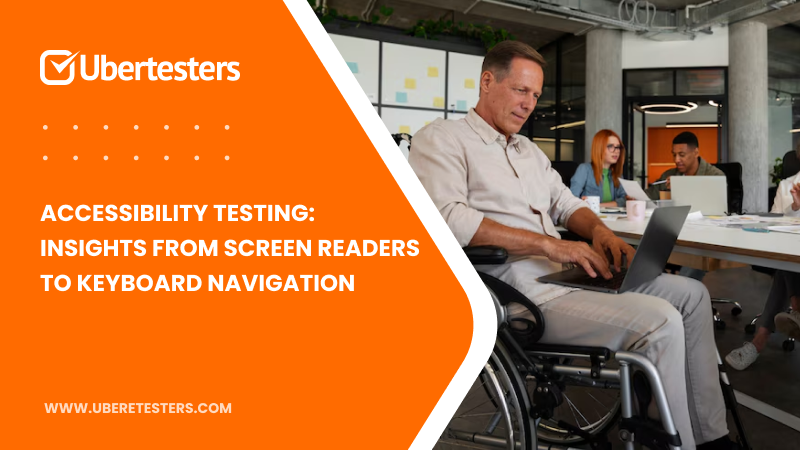Essential Accessibility Testing Techniques

Over 1.3 billion people—about 16% of the global population—live with some form of disability, according to the World Health Organization. That’s a staggering number, and yet many websites still fail to meet basic accessibility standards. Regulations like the Web Content Accessibility Guidelines (WCAG) and the Americans with Disabilities Act (ADA) emphasize the importance of creating digital environments that everyone can use. That’s where accessibility testing comes in—it ensures that your digital product works for all users, including those with disabilities. Inaccessible websites can lead to lost customers, legal risk, and reputational damage. Accessibility isn’t just a social good—it’s a business necessity, especially for organizations working with public institutions or global audiences.
When it comes to testing website accessibility, several critical focus areas demand attention: screen readers, keyboard navigation, visual accessibility, focus management, alternative text, and captions. In this article, we’ll dive deep into each of these elements, share real-world insights, and explain why including real user accessibility testing makes all the difference.
Why Automated Tools Alone Aren’t Enough
Automated tools like Axe, Lighthouse, or WAVE are great starting points. They can quickly identify missing labels, low color contrast, or broken ARIA attributes. But they have one serious limitation: they don’t think like humans.
Why Automated Accessibility Tests Miss Real-World Issues
Automation checks for code-level compliance, not actual usability. A page might pass an audit but still be impossible for a blind user to navigate or understand. For example:
- A button might be labeled “click here,” which technically includes alt text—but isn’t meaningful.
- A form field might have the correct aria-label, but in practice, it’s read out of order.
- Keyboard focus might technically exist, but it’s not visible or intuitive.
Only manual accessibility testing and UX testing can reveal these kinds of problems. Real users provide feedback that no algorithm can simulate.
Tools are important, but real impact comes from testing how people actually experience your product. This is especially true in industries like fintech, healthcare, and e-commerce—where usability gaps can directly impact conversion or trust.
The Role of Crowd Testing in Accessibility

Automation and in-house testing can only take you so far. To truly understand how your product performs, you need input from real people with real experiences.
Crowd testing accessibility involves working with a diverse group of users—including those with disabilities—to evaluate your product in real-world conditions. These testers use their personal devices, assistive technologies, and browsing habits, which brings a level of authenticity that lab environments often lack.
Benefits of crowdsourced accessibility testing include:
- Identifying edge cases not found in scripted tests
- Testing across multiple devices and screen readers
- Discovering pain points in real-time usage
Crowdsourced testing also helps build empathy in your team. When developers and designers read direct feedback from users struggling to navigate a site, it sparks meaningful change.
At Ubertesters, we work with real users from around the world—many of whom rely on assistive technologies daily. This global network helps our clients go beyond basic compliance and deliver experiences that actually work in practice.
Keyboard Navigation

Many users rely on keyboards instead of mice, especially those with motor impairments, vision loss, or repetitive strain injuries. For them, intuitive keyboard navigation testing is essential.
Why Keyboard-Only Navigation Matters
Without a working keyboard experience, users can’t:
- Navigate menus
- Submit forms
- Access modal content
- Skip repetitive navigation
These aren’t just inconveniences—they’re roadblocks to access.
What to Test in Keyboard Navigation
Effective keyboard navigation testing should include:
- Tab order: Does focus move logically through interactive elements?
- Focus visibility: Is it clear where the user is on the screen?
- Skip links: Can users bypass headers or menus to jump to content?
- Menu access: Are dropdowns and modals accessible via keyboard?
How Real Testers Simulate and Report Issues
Manual accessibility testing often involves using only the Tab, Shift+Tab, Enter, and arrow keys. Real users document moments when focus disappears, loops, or lands on inactive elements. This kind of real user accessibility testing is vital for surfacing bugs that automated scans miss.
Screen Reader Testing
Screen reader testing simulates how blind or visually impaired users interact with a website. Popular screen readers include:
- NVDA (Windows, free)
- JAWS (Windows, commercial)
- VoiceOver (macOS/iOS, built-in)
Why Screen Reader Compatibility Is Crucial
For non-sighted users, screen readers are the gateway to digital content. Poor web accessibility testing here can result in an unusable site.
Common Issues Uncovered in Screen Reader Testing
Some frequent problems include:
- Missing labels: Screen readers read out “button” instead of “submit form.”
- Incorrect reading order: Content is read in a confusing sequence.
- Poor heading structure: Makes navigation difficult.
- Misuse of ARIA roles: Causes information to be miscommunicated or duplicated.
Real Users Bring Real Value
While developers can test with screen readers, users who rely on them daily provide far deeper insights. Their feedback is grounded in experience, not simulation, which makes crowd-testing accessibility especially effective in this area.
Visual Accessibility

Visual accessibility covers how users with limited or altered vision perceive content. It’s not just about blindness—it includes color blindness, low vision, and even temporary impairments.
Key Elements of Visual Accessibility
A well-designed interface considers:
- Color contrast: Is text readable against its background?
- Font size and scalability: Does text resize without breaking layout?
- Clear layouts: Is content logically grouped and aligned?
- Minimal motion: Are animations distracting or disorienting?
How Users Experience Design Differently
Users with low vision might zoom in to 200%. If your layout breaks or hides content when magnified, that’s a fail. Those with color blindness may not distinguish between red and green buttons. This is where inclusive design testing matters.
Validating Design Choices with Diverse Testers
Using crowd testers with various vision levels ensures your visual accessibility strategies are truly effective. It’s the most reliable way to confirm that your layout and design meet real-world needs.
Focus Management
Focus management in accessibility ensures users always know where they are and can move through a page without getting lost or stuck.
Why Focus Management Is Essential
Poor focus management results in:
- Focus traps: Users get stuck in modals or navigation drawers.
- Lost focus: After an action, focus lands on nothing.
- Invisible focus: Focus exists but can’t be seen.
Common Pitfalls in Focus Management
Designers often forget to return focus after modal closures or to set focus to dynamic content, such as error messages. These mistakes make pages frustrating or unusable for assistive tech users. For example, if a user clicks “submit” on a form and the focus doesn’t move to the confirmation message—or worse, disappears entirely—they may think nothing happened. These are the moments that make or break user trust.
How Crowd Testing Reveals Broken Focus Flows
By assessing across various devices and browsers, crowd testing accessibility helps reveal inconsistencies in focus behavior. Testers log issues as they experience them—whether on Windows with NVDA or iPhones with VoiceOver—providing data that developers can act on immediately.
Alternative Text and Captions
Alternative text testing and captions help users who rely on screen readers or can’t hear multimedia content. Alternative text for images and accurate video captions are essential for web accessibility testing. Without them, users miss important content.
How to Test for Effectiveness
Don’t just check if alt text exists—ask:
- Is the description meaningful and concise?
- Does it match the context of the page?
- Are decorative images marked as such to avoid clutter?
Similarly, captions should:
- Accurately reflect spoken content
- Include non-verbal sounds (e.g., [laughter], [music])
- Be synchronized with the audio
This is where using real users to test alternative text for images matters. A sighted developer might think “image of a woman” is fine. A blind user will ask: What is she doing? Is she smiling? What’s the context?
Diverse Testers Ensure Clarity
Crowd testing accessibility ensures your alt text and captions are not only present but also meaningful. Real users validate whether the content truly conveys the intended message.
Wrap-Up

Digital accessibility isn’t just about checking boxes—it’s about ensuring every user, regardless of ability, can access your content. From keyboard navigation and screen reader testing to focus management in accessibility and alternative text testing, each technique offers a vital piece of the puzzle.
Automated tools are useful, but they can’t replace the insights from manual accessibility testing and real user accessibility assessments. When you bring in diverse testers through crowd testing accessibility, you catch the usability gaps that machines miss. You also create more inclusive, empathetic digital experiences.
Ubertesters supports companies in achieving real accessibility—by combining experienced testers, global coverage, and practical feedback you can act on. If you’re ready to take the next step in accessible UX testing, contact us today. We’ll help you build a product that works beautifully for everyone—because accessibility isn’t optional. It’s essential.

